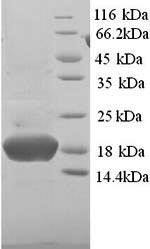The recombinant Human PHPT1 was expressed with the amino acid range of 1-125. The calculated molecular weight for this PHPT1 protein is 15.8 kDa. Expression of this PHPT1 protein is conducted in yeast. The PHPT1 gene fragment has been modified by fusing the N-terminal 6xHis tag, providing convenience in detecting and purifying the recombinant PHPT1 protein during the following stages.
The human 14 kDa Phosphohistidine Phosphatase (PHPT1) plays a crucial role in cellular signaling by catalyzing the dephosphorylation of phosphohistidine residues. Histidine phosphorylation is a reversible post-translational modification involved in the regulation of various cellular processes, including signal transduction and metabolic pathways. PHPT1 specifically targets proteins containing phosphohistidine residues and hydrolyzes the phosphate group, thereby regulating the activity of these proteins. Its activity is essential for maintaining the dynamic balance of histidine phosphorylation in cells. Research on PHPT1 spans cell signaling, enzymology, and its potential implications in cellular homeostasis and disease. Understanding the precise regulatory mechanisms involving PHPT1 provides insights into the intricate network of cellular signaling pathways and their impact on cellular functions.






